3102AFE Auditing Assignment: Risk Assessment of Hamilton Limited
VerifiedAdded on 2022/07/28
|7
|1672
|22
Report
AI Summary
This report is a comprehensive analysis of risk assessment in the context of auditing, specifically focusing on Hamilton Limited. The assignment delves into key concepts such as inherent risk, control risk, and audit risk, evaluating their potential impact on the audit process. It examines factors contributing to inherent risk, including the accessibility of accounting records and the complexity of the accounting system. The report also assesses control risk, highlighting issues in the recording of sales transactions and governance over review reports. Furthermore, the assignment explores the audit risk model, assigning low-risk factors to the identified risks. The report proposes analytical procedures, such as the use of ERP systems, to identify misstatements in sales recording and suggests controls, including scanning sales bills, and tests of control, such as dummy bills and sample examinations. The report concludes with references to relevant auditing literature.
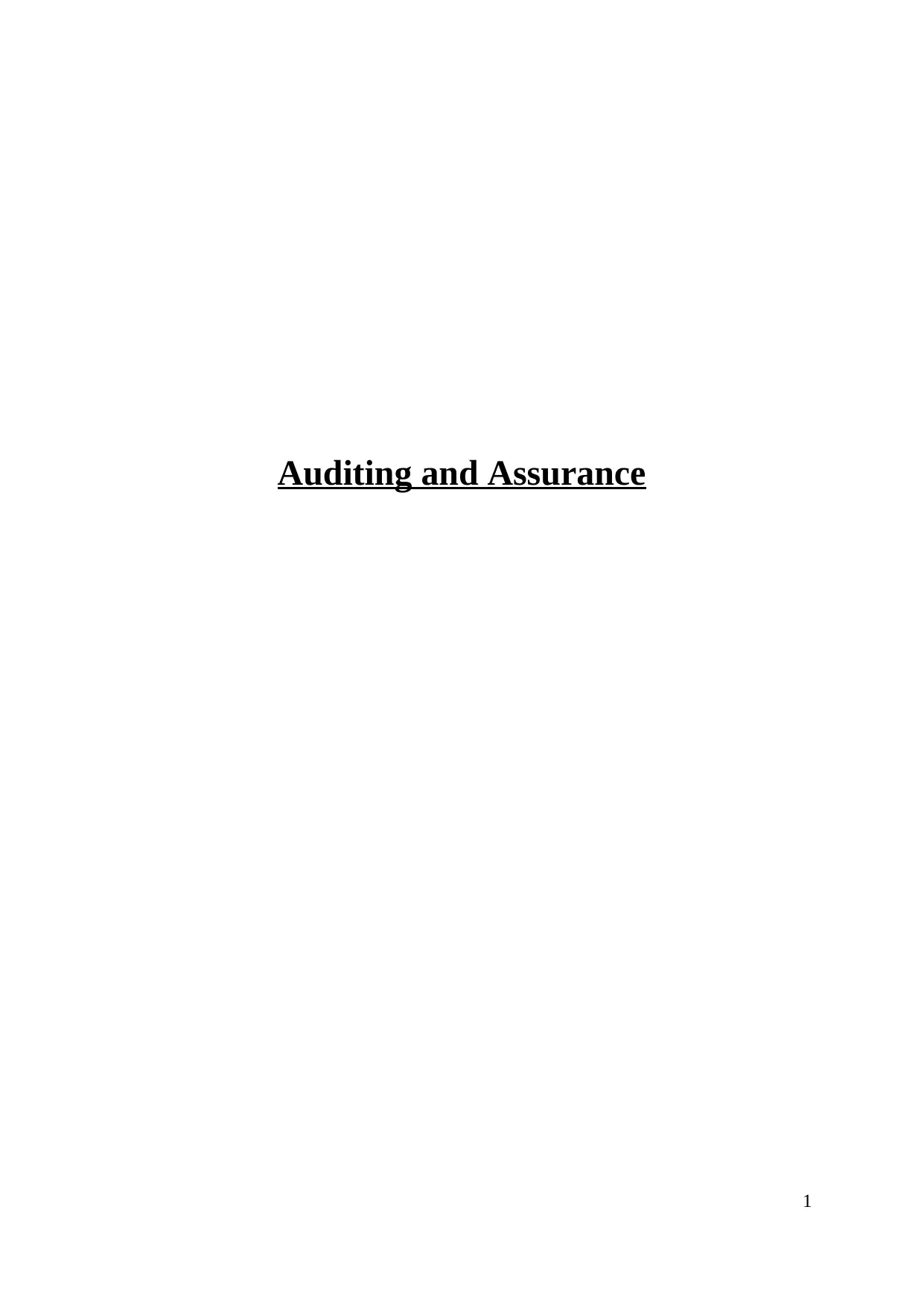
Auditing and Assurance
1
1
Paraphrase This Document
Need a fresh take? Get an instant paraphrase of this document with our AI Paraphraser
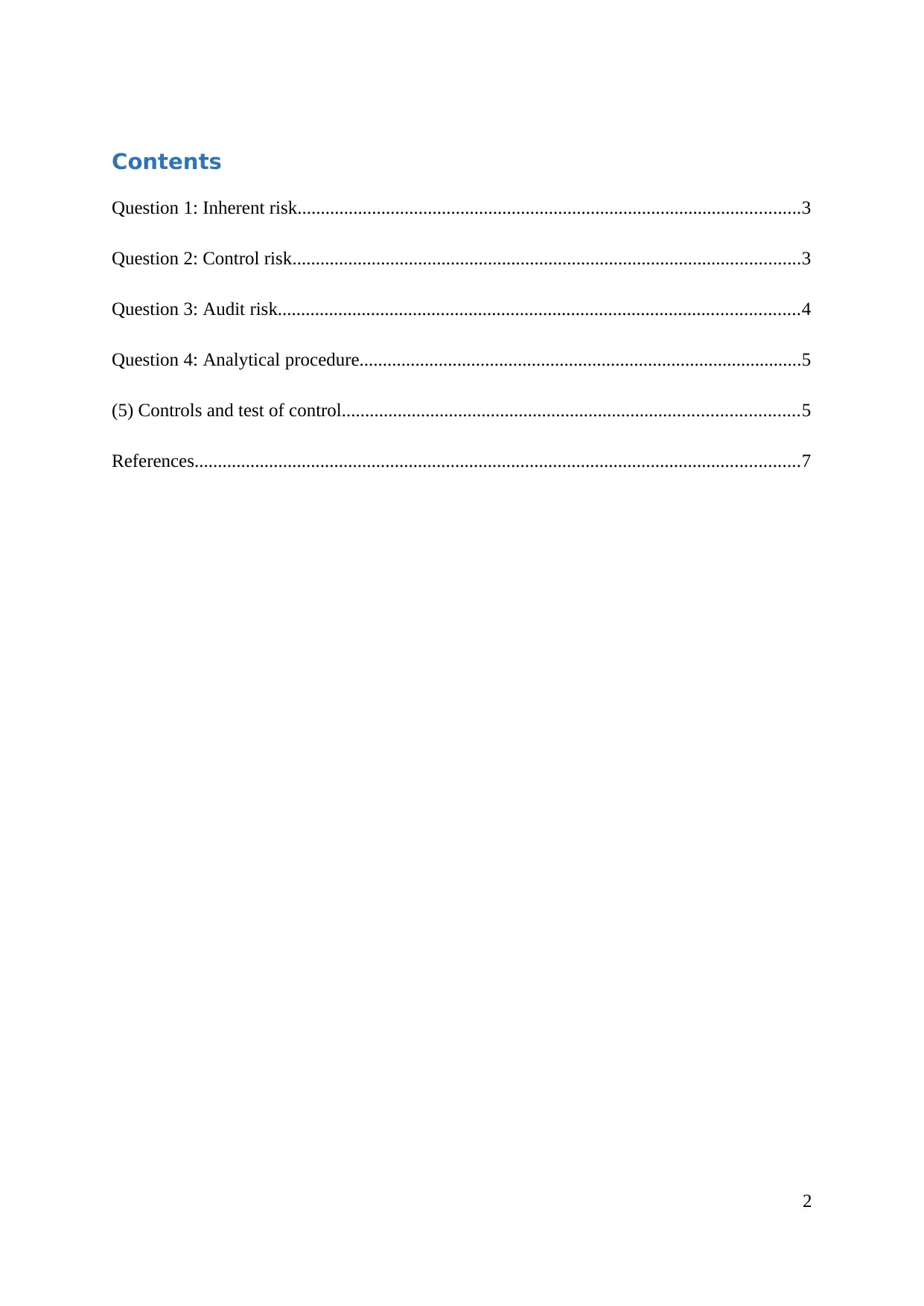
Contents
Question 1: Inherent risk............................................................................................................3
Question 2: Control risk.............................................................................................................3
Question 3: Audit risk................................................................................................................4
Question 4: Analytical procedure...............................................................................................5
(5) Controls and test of control..................................................................................................5
References..................................................................................................................................7
2
Question 1: Inherent risk............................................................................................................3
Question 2: Control risk.............................................................................................................3
Question 3: Audit risk................................................................................................................4
Question 4: Analytical procedure...............................................................................................5
(5) Controls and test of control..................................................................................................5
References..................................................................................................................................7
2
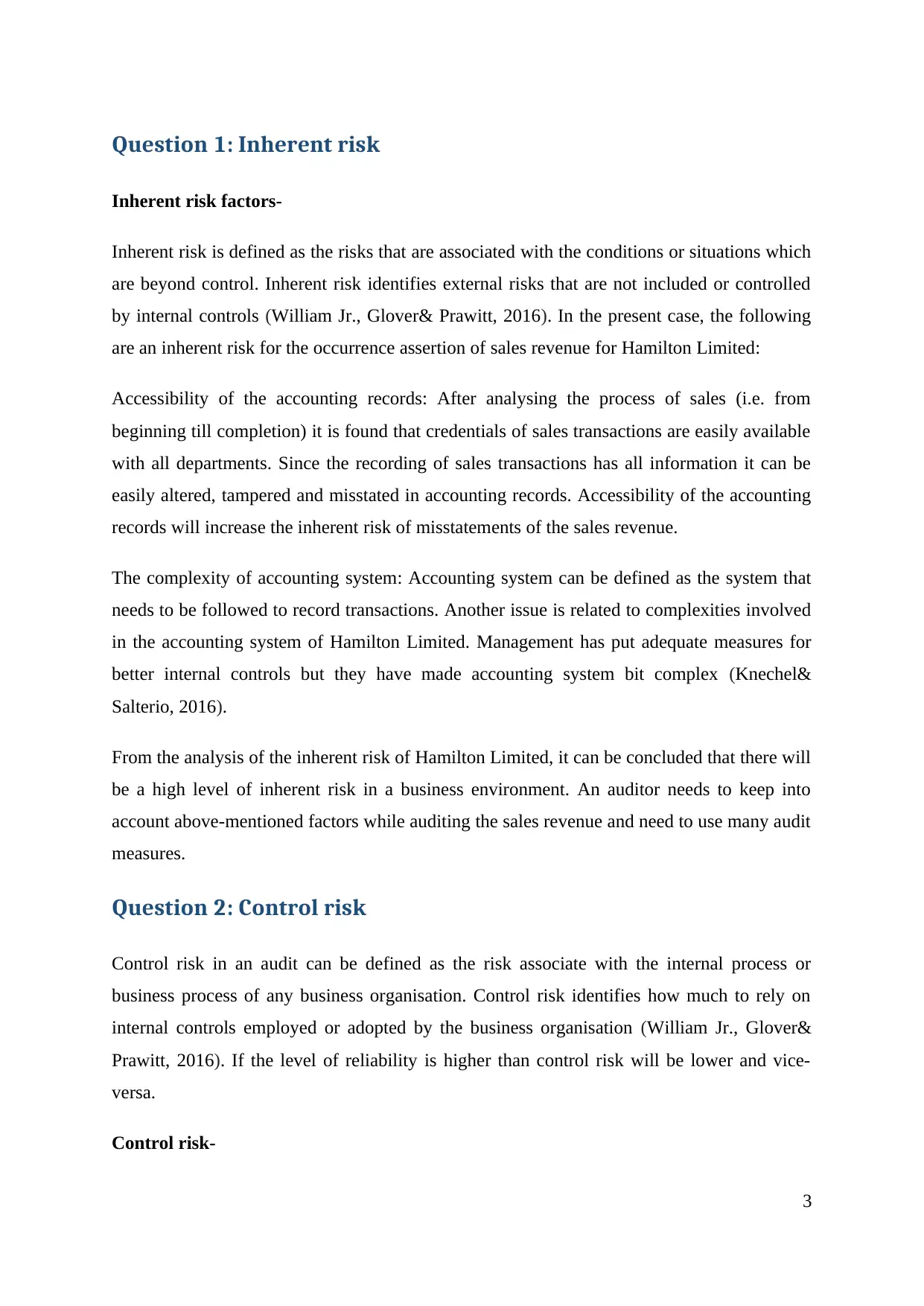
Question 1: Inherent risk
Inherent risk factors-
Inherent risk is defined as the risks that are associated with the conditions or situations which
are beyond control. Inherent risk identifies external risks that are not included or controlled
by internal controls (William Jr., Glover& Prawitt, 2016). In the present case, the following
are an inherent risk for the occurrence assertion of sales revenue for Hamilton Limited:
Accessibility of the accounting records: After analysing the process of sales (i.e. from
beginning till completion) it is found that credentials of sales transactions are easily available
with all departments. Since the recording of sales transactions has all information it can be
easily altered, tampered and misstated in accounting records. Accessibility of the accounting
records will increase the inherent risk of misstatements of the sales revenue.
The complexity of accounting system: Accounting system can be defined as the system that
needs to be followed to record transactions. Another issue is related to complexities involved
in the accounting system of Hamilton Limited. Management has put adequate measures for
better internal controls but they have made accounting system bit complex (Knechel&
Salterio, 2016).
From the analysis of the inherent risk of Hamilton Limited, it can be concluded that there will
be a high level of inherent risk in a business environment. An auditor needs to keep into
account above-mentioned factors while auditing the sales revenue and need to use many audit
measures.
Question 2: Control risk
Control risk in an audit can be defined as the risk associate with the internal process or
business process of any business organisation. Control risk identifies how much to rely on
internal controls employed or adopted by the business organisation (William Jr., Glover&
Prawitt, 2016). If the level of reliability is higher than control risk will be lower and vice-
versa.
Control risk-
3
Inherent risk factors-
Inherent risk is defined as the risks that are associated with the conditions or situations which
are beyond control. Inherent risk identifies external risks that are not included or controlled
by internal controls (William Jr., Glover& Prawitt, 2016). In the present case, the following
are an inherent risk for the occurrence assertion of sales revenue for Hamilton Limited:
Accessibility of the accounting records: After analysing the process of sales (i.e. from
beginning till completion) it is found that credentials of sales transactions are easily available
with all departments. Since the recording of sales transactions has all information it can be
easily altered, tampered and misstated in accounting records. Accessibility of the accounting
records will increase the inherent risk of misstatements of the sales revenue.
The complexity of accounting system: Accounting system can be defined as the system that
needs to be followed to record transactions. Another issue is related to complexities involved
in the accounting system of Hamilton Limited. Management has put adequate measures for
better internal controls but they have made accounting system bit complex (Knechel&
Salterio, 2016).
From the analysis of the inherent risk of Hamilton Limited, it can be concluded that there will
be a high level of inherent risk in a business environment. An auditor needs to keep into
account above-mentioned factors while auditing the sales revenue and need to use many audit
measures.
Question 2: Control risk
Control risk in an audit can be defined as the risk associate with the internal process or
business process of any business organisation. Control risk identifies how much to rely on
internal controls employed or adopted by the business organisation (William Jr., Glover&
Prawitt, 2016). If the level of reliability is higher than control risk will be lower and vice-
versa.
Control risk-
3
⊘ This is a preview!⊘
Do you want full access?
Subscribe today to unlock all pages.

Trusted by 1+ million students worldwide
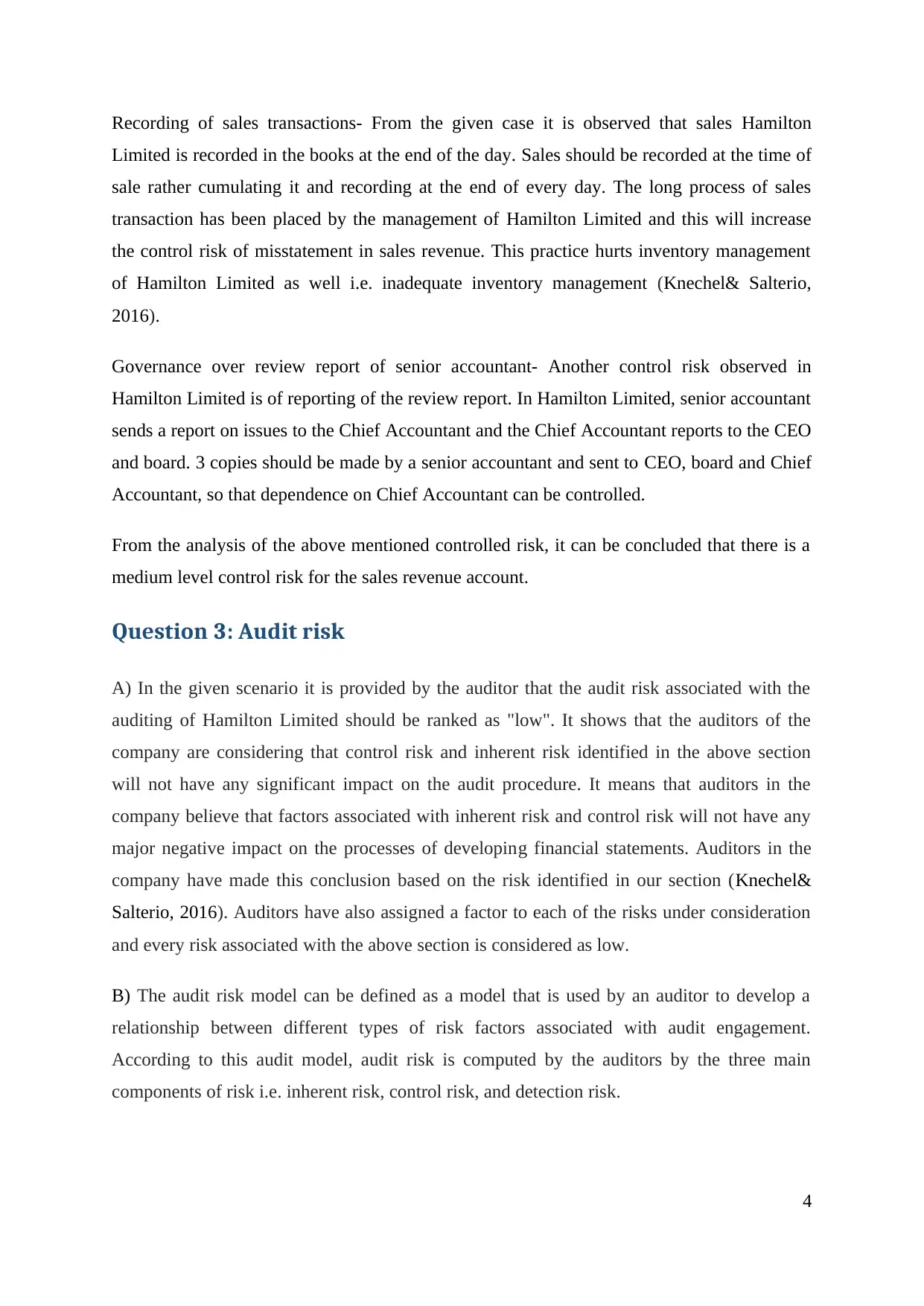
Recording of sales transactions- From the given case it is observed that sales Hamilton
Limited is recorded in the books at the end of the day. Sales should be recorded at the time of
sale rather cumulating it and recording at the end of every day. The long process of sales
transaction has been placed by the management of Hamilton Limited and this will increase
the control risk of misstatement in sales revenue. This practice hurts inventory management
of Hamilton Limited as well i.e. inadequate inventory management (Knechel& Salterio,
2016).
Governance over review report of senior accountant- Another control risk observed in
Hamilton Limited is of reporting of the review report. In Hamilton Limited, senior accountant
sends a report on issues to the Chief Accountant and the Chief Accountant reports to the CEO
and board. 3 copies should be made by a senior accountant and sent to CEO, board and Chief
Accountant, so that dependence on Chief Accountant can be controlled.
From the analysis of the above mentioned controlled risk, it can be concluded that there is a
medium level control risk for the sales revenue account.
Question 3: Audit risk
A) In the given scenario it is provided by the auditor that the audit risk associated with the
auditing of Hamilton Limited should be ranked as "low". It shows that the auditors of the
company are considering that control risk and inherent risk identified in the above section
will not have any significant impact on the audit procedure. It means that auditors in the
company believe that factors associated with inherent risk and control risk will not have any
major negative impact on the processes of developing financial statements. Auditors in the
company have made this conclusion based on the risk identified in our section (Knechel&
Salterio, 2016). Auditors have also assigned a factor to each of the risks under consideration
and every risk associated with the above section is considered as low.
B) The audit risk model can be defined as a model that is used by an auditor to develop a
relationship between different types of risk factors associated with audit engagement.
According to this audit model, audit risk is computed by the auditors by the three main
components of risk i.e. inherent risk, control risk, and detection risk.
4
Limited is recorded in the books at the end of the day. Sales should be recorded at the time of
sale rather cumulating it and recording at the end of every day. The long process of sales
transaction has been placed by the management of Hamilton Limited and this will increase
the control risk of misstatement in sales revenue. This practice hurts inventory management
of Hamilton Limited as well i.e. inadequate inventory management (Knechel& Salterio,
2016).
Governance over review report of senior accountant- Another control risk observed in
Hamilton Limited is of reporting of the review report. In Hamilton Limited, senior accountant
sends a report on issues to the Chief Accountant and the Chief Accountant reports to the CEO
and board. 3 copies should be made by a senior accountant and sent to CEO, board and Chief
Accountant, so that dependence on Chief Accountant can be controlled.
From the analysis of the above mentioned controlled risk, it can be concluded that there is a
medium level control risk for the sales revenue account.
Question 3: Audit risk
A) In the given scenario it is provided by the auditor that the audit risk associated with the
auditing of Hamilton Limited should be ranked as "low". It shows that the auditors of the
company are considering that control risk and inherent risk identified in the above section
will not have any significant impact on the audit procedure. It means that auditors in the
company believe that factors associated with inherent risk and control risk will not have any
major negative impact on the processes of developing financial statements. Auditors in the
company have made this conclusion based on the risk identified in our section (Knechel&
Salterio, 2016). Auditors have also assigned a factor to each of the risks under consideration
and every risk associated with the above section is considered as low.
B) The audit risk model can be defined as a model that is used by an auditor to develop a
relationship between different types of risk factors associated with audit engagement.
According to this audit model, audit risk is computed by the auditors by the three main
components of risk i.e. inherent risk, control risk, and detection risk.
4
Paraphrase This Document
Need a fresh take? Get an instant paraphrase of this document with our AI Paraphraser
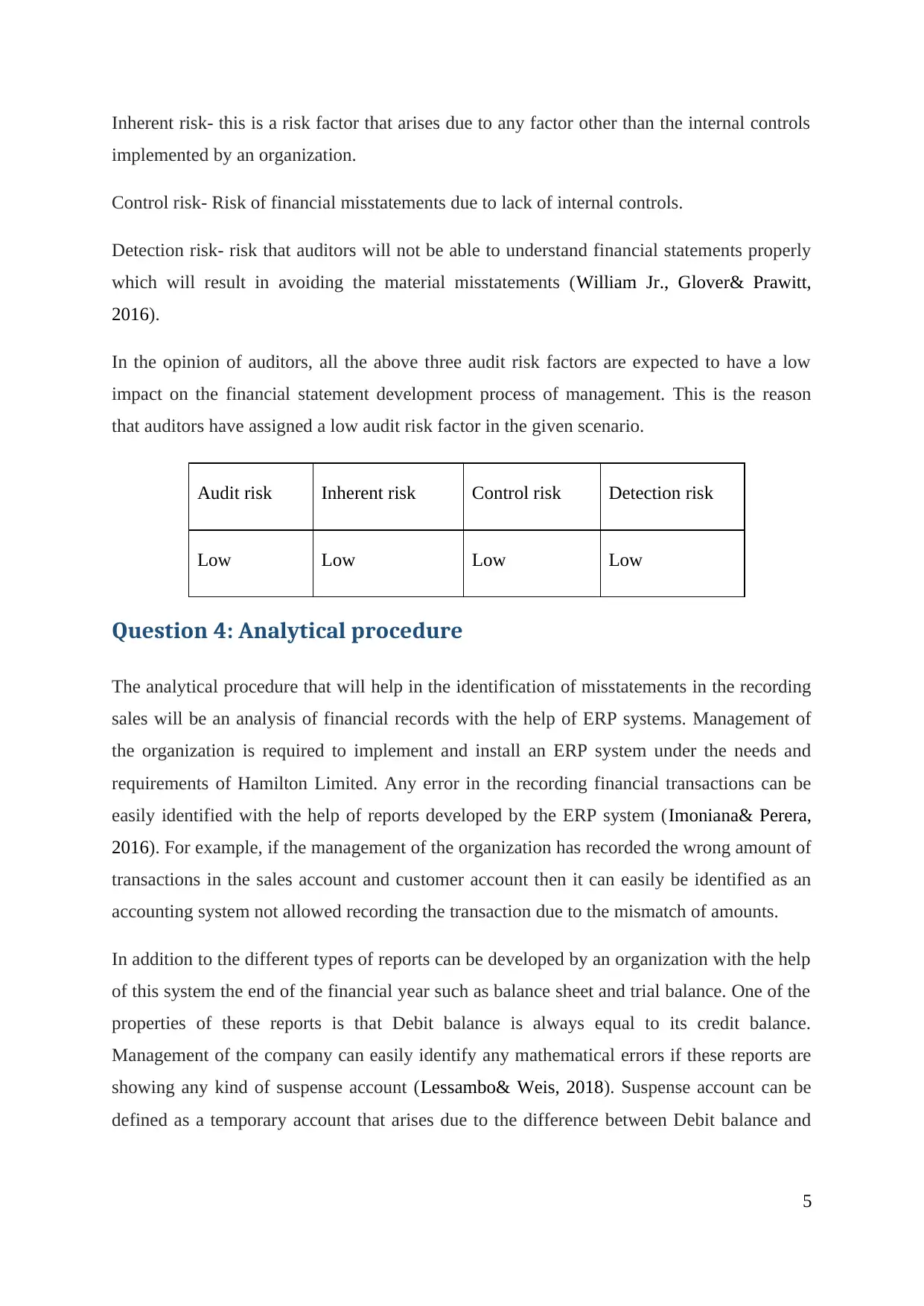
Inherent risk- this is a risk factor that arises due to any factor other than the internal controls
implemented by an organization.
Control risk- Risk of financial misstatements due to lack of internal controls.
Detection risk- risk that auditors will not be able to understand financial statements properly
which will result in avoiding the material misstatements (William Jr., Glover& Prawitt,
2016).
In the opinion of auditors, all the above three audit risk factors are expected to have a low
impact on the financial statement development process of management. This is the reason
that auditors have assigned a low audit risk factor in the given scenario.
Audit risk Inherent risk Control risk Detection risk
Low Low Low Low
Question 4: Analytical procedure
The analytical procedure that will help in the identification of misstatements in the recording
sales will be an analysis of financial records with the help of ERP systems. Management of
the organization is required to implement and install an ERP system under the needs and
requirements of Hamilton Limited. Any error in the recording financial transactions can be
easily identified with the help of reports developed by the ERP system (Imoniana& Perera,
2016). For example, if the management of the organization has recorded the wrong amount of
transactions in the sales account and customer account then it can easily be identified as an
accounting system not allowed recording the transaction due to the mismatch of amounts.
In addition to the different types of reports can be developed by an organization with the help
of this system the end of the financial year such as balance sheet and trial balance. One of the
properties of these reports is that Debit balance is always equal to its credit balance.
Management of the company can easily identify any mathematical errors if these reports are
showing any kind of suspense account (Lessambo& Weis, 2018). Suspense account can be
defined as a temporary account that arises due to the difference between Debit balance and
5
implemented by an organization.
Control risk- Risk of financial misstatements due to lack of internal controls.
Detection risk- risk that auditors will not be able to understand financial statements properly
which will result in avoiding the material misstatements (William Jr., Glover& Prawitt,
2016).
In the opinion of auditors, all the above three audit risk factors are expected to have a low
impact on the financial statement development process of management. This is the reason
that auditors have assigned a low audit risk factor in the given scenario.
Audit risk Inherent risk Control risk Detection risk
Low Low Low Low
Question 4: Analytical procedure
The analytical procedure that will help in the identification of misstatements in the recording
sales will be an analysis of financial records with the help of ERP systems. Management of
the organization is required to implement and install an ERP system under the needs and
requirements of Hamilton Limited. Any error in the recording financial transactions can be
easily identified with the help of reports developed by the ERP system (Imoniana& Perera,
2016). For example, if the management of the organization has recorded the wrong amount of
transactions in the sales account and customer account then it can easily be identified as an
accounting system not allowed recording the transaction due to the mismatch of amounts.
In addition to the different types of reports can be developed by an organization with the help
of this system the end of the financial year such as balance sheet and trial balance. One of the
properties of these reports is that Debit balance is always equal to its credit balance.
Management of the company can easily identify any mathematical errors if these reports are
showing any kind of suspense account (Lessambo& Weis, 2018). Suspense account can be
defined as a temporary account that arises due to the difference between Debit balance and
5

credit balance of trial balance or balance sheet. Transactions that are affecting the suspense
account can be identified separately and changes can be made accordingly.
(5) Controls and test of control
Control
Well, design control for the prevention and detection of misstatements in the recording of
revenue will be “scanning sales bills”. It should be made compulsory for every employee in
the organization that is issuing sales invoices to customers to make sure that each sales
invoice is scanned and stored in the computer system. This will help in ensuring that there is
a supporting document associated with every revenue transactions undertaken by the
company. In addition to that this will also help in ensuring that records can be checked and
matched with the internal documents/ physical evidence (Farooq& De Villiers, 2017). This
will also provide an audit trail for auditors as the examination of these records will also
become very easy.
Test of control
Two types of the test of controls can be implemented in the organization-
Dummy bills- This test of control will be the responsibility of the chief executive officer of
the chief accounting officer. Best of control dummy bills will be distributed by the chief
accounting officer to the person that is recording the financial transaction. A proper record of
these bills will be taken by the chief accounting officer. Before the development of financial
accounts, the chief financial officer will be required to identify whether these dummy beds
have been recorded and scanned in the system or not (Akhmetshin et.al, 2018).
Sample examination- Examination of the scanned bill and comparing it with the sales
transaction can be undertaken by the chief accounting officer quarterly. This type of analysis
will be done by the Chief accounting officer on a random sample basis. This will also help in
identifying whether all the sales transactions are being scanned or not.
6
account can be identified separately and changes can be made accordingly.
(5) Controls and test of control
Control
Well, design control for the prevention and detection of misstatements in the recording of
revenue will be “scanning sales bills”. It should be made compulsory for every employee in
the organization that is issuing sales invoices to customers to make sure that each sales
invoice is scanned and stored in the computer system. This will help in ensuring that there is
a supporting document associated with every revenue transactions undertaken by the
company. In addition to that this will also help in ensuring that records can be checked and
matched with the internal documents/ physical evidence (Farooq& De Villiers, 2017). This
will also provide an audit trail for auditors as the examination of these records will also
become very easy.
Test of control
Two types of the test of controls can be implemented in the organization-
Dummy bills- This test of control will be the responsibility of the chief executive officer of
the chief accounting officer. Best of control dummy bills will be distributed by the chief
accounting officer to the person that is recording the financial transaction. A proper record of
these bills will be taken by the chief accounting officer. Before the development of financial
accounts, the chief financial officer will be required to identify whether these dummy beds
have been recorded and scanned in the system or not (Akhmetshin et.al, 2018).
Sample examination- Examination of the scanned bill and comparing it with the sales
transaction can be undertaken by the chief accounting officer quarterly. This type of analysis
will be done by the Chief accounting officer on a random sample basis. This will also help in
identifying whether all the sales transactions are being scanned or not.
6
⊘ This is a preview!⊘
Do you want full access?
Subscribe today to unlock all pages.

Trusted by 1+ million students worldwide
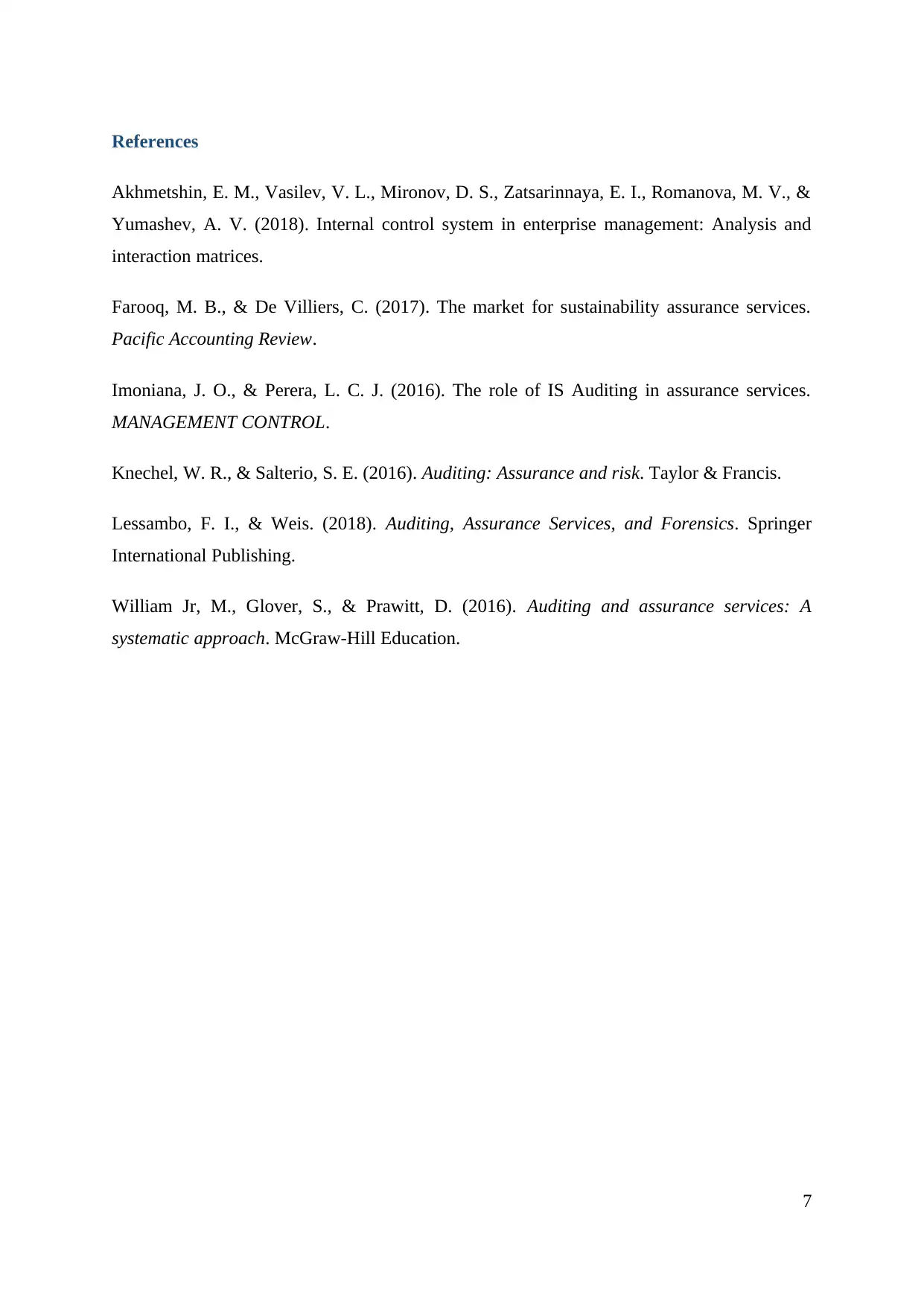
References
Akhmetshin, E. M., Vasilev, V. L., Mironov, D. S., Zatsarinnaya, Е. I., Romanova, M. V., &
Yumashev, A. V. (2018). Internal control system in enterprise management: Analysis and
interaction matrices.
Farooq, M. B., & De Villiers, C. (2017). The market for sustainability assurance services.
Pacific Accounting Review.
Imoniana, J. O., & Perera, L. C. J. (2016). The role of IS Auditing in assurance services.
MANAGEMENT CONTROL.
Knechel, W. R., & Salterio, S. E. (2016). Auditing: Assurance and risk. Taylor & Francis.
Lessambo, F. I., & Weis. (2018). Auditing, Assurance Services, and Forensics. Springer
International Publishing.
William Jr, M., Glover, S., & Prawitt, D. (2016). Auditing and assurance services: A
systematic approach. McGraw-Hill Education.
7
Akhmetshin, E. M., Vasilev, V. L., Mironov, D. S., Zatsarinnaya, Е. I., Romanova, M. V., &
Yumashev, A. V. (2018). Internal control system in enterprise management: Analysis and
interaction matrices.
Farooq, M. B., & De Villiers, C. (2017). The market for sustainability assurance services.
Pacific Accounting Review.
Imoniana, J. O., & Perera, L. C. J. (2016). The role of IS Auditing in assurance services.
MANAGEMENT CONTROL.
Knechel, W. R., & Salterio, S. E. (2016). Auditing: Assurance and risk. Taylor & Francis.
Lessambo, F. I., & Weis. (2018). Auditing, Assurance Services, and Forensics. Springer
International Publishing.
William Jr, M., Glover, S., & Prawitt, D. (2016). Auditing and assurance services: A
systematic approach. McGraw-Hill Education.
7
1 out of 7
Related Documents
Your All-in-One AI-Powered Toolkit for Academic Success.
+13062052269
info@desklib.com
Available 24*7 on WhatsApp / Email
![[object Object]](/_next/static/media/star-bottom.7253800d.svg)
Unlock your academic potential
Copyright © 2020–2025 A2Z Services. All Rights Reserved. Developed and managed by ZUCOL.





